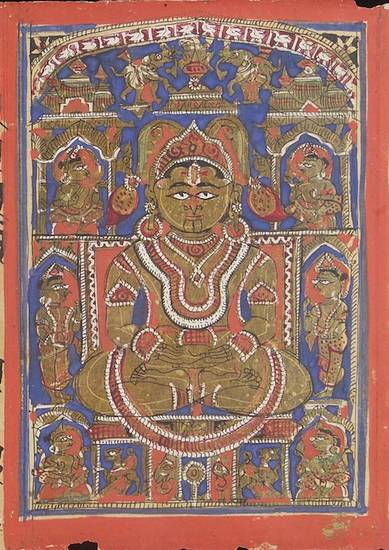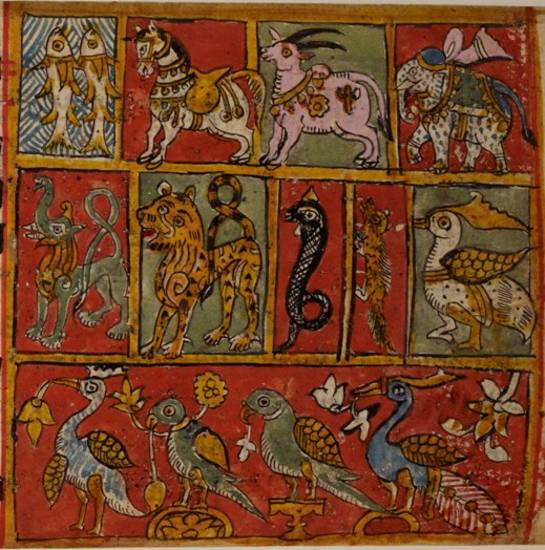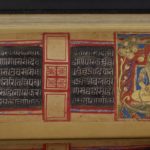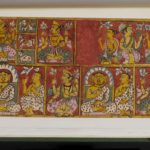Article: Cycle of rebirth
The cycle of birth – saṃsāra – is one of the principal theories in Jain belief and is closely linked to the concepts of the soul and karma. Literally meaning ‘wandering around’ in Sanskrit, the term saṃsāra describes the recurring process in which a soul is born into a body, which lives and dies, and then is reborn into a different body. Jains believe that this event repeats endlessly for souls that have karmas bound to them. The aim of Jainism is liberation of the soul from this cycle, which requires the soul to be free of karma.
The Jains also call the concept the ‘river of rebirth’, which explains why the term Tīrthaṃkara is frequently used as a synonym for Jina. Meaning ‘ford-breaker’, Tīrthaṃkara emphasises that the Jinas have led the way to liberation – mokṣa – and left a path for others to follow.
Rebirth can take place in one of four conditions – gatis – which relate to the karmas gathered in previous lifetimes. All activities and thoughts create karmas, which can be negative or positive. Bad karmas lead to rebirth as a creature of low spirituality and minimal senses, whereas good karmas effect birth as a god or human being. The most desirable condition is that of the human being, because liberation is impossible for any other kind of being.
The Jain cycle of rebirths is similar to the saṃsāra found in Hinduism and Buddhism, but is different in that the transmigration of the soul from one body to another is instant. There are other major differences in religious tenets that influence the various conceptions of the cycle of births.
This piece is a summary of the article "Cycle of rebirth". The full article will be available soon.
Endless cycle
The concept of continuous rebirth is one of the principal Jain beliefs. Jains hold that a soul exists within one physical body, dies and is then born into a different body in a different life, with this process repeating. This continues for eternity or until the soul is free of all karma. The liberation of the soul from the cycle of rebirth – mokṣa – is the ultimate aim of Jainism.
The cycle of births is usually considered to be aeons long for each soul, with the soul reborn many many times in different lifetimes. The traditional number of rebirths is 8,400,000. Only souls that become Jinas have few births. The 24th Jina Mahāvīra, for instance, is said to have had 27 rebirths before the last, when he became a Jina. Various numbers of rebirths are given for other Jinas. In each lifetime or birth a soul may develop spiritually or it may deteriorate spiritually, which influences future births. Spiritual progress can be tracked against the 14 stages of the ‘scale of perfection’ – guṇa-sthāna – which links conduct and beliefs to level of spirituality. Spiritual development is not a straightforward advance, as the diverse conditions of the various births and the activities in different lives all influence karma‘s interaction with the soul. The Jain game of gyanbazi, which is similar to the Western game of snakes and ladders, clearly sets out the ups and downs of the soul’s journey.
Eventually, a soul may develop spiritually enough to free itself of old karmas and avoid creating new ones. It then gains omniscience or enlightenment and, when its body dies, can become a liberated soul – siddha. Instead of being born into another life, it remains disembodied and rises to the siddha-śilā, at the apex of the universe. This place is where all the siddhas dwell together, enjoying the realisation of their true nature of perfection.
Rebirths
When a soul enters a new birth, it is born into a body and life according to the karma it has gained in previous lives.
The soul can be born in one of the following conditions – gatis:
- a human being – manuṣya-gati
- a heavenly being, living in the heavens – deva-gati
- an infernal being, living in the hells – nāraka-gati
- an animal or plant – tiryag-gati.
Activities and thoughts during a lifetime create karmas, which may be positive or negative. Positive karmas arise from behaviour Jains consider meritorious, such as giving alms to mendicants and avoiding violence. Negative karmas are generated by conduct condemned in Jain scriptures, such as lying, being greedy or committing deliberate violence.
Gathering positive karmas may lead to birth as a god or human being. Having lots of negative karmas may result in birth as an animal or even an insect, plant or hellish being. This makes it difficult to follow Jain principles and gain enough positive karma to be born in a better condition in the next life. However, even a soul born as a god is trapped within the cycle of births. The best condition to be born into is that of a human, because it is the only one in which the soul can be liberated.
Indian religions and the soul
Along with other religions that originated in India, such as Hinduism and Buddhism, Jains believe that souls:
- are trapped in the neverending cycle of rebirth – saṃsāra
- are reborn in different bodies according to the karma they have collected
- can only break out of the cycle of rebirth by being born a human being, achieving enlightenment and then, leaving the body behind, reaching liberation
- with karma attached to them can never be enlightened – the bondage of karma.
The Jain concepts of the soul and karma differ from those of the other Indian faiths, however. In Jainism souls are individual with the same innate qualities. They accrue karmas that are bound to them throughout the cycle of birth until they mature and fall away. Souls remain individual once they are perfected. In the Jain concept of saṃsāra, on the death of the body the soul moves almost immediately to the next new body. This is different from saṃsāra in Hindu and Buddhist thought.
Followers of the Buddha do not believe in a soul in the same way as Jains and Hindus. The Buddha preached anatta – the doctrine of no soul – and that the cycle of birth involves a transfer of consciousness from one body to another, influenced by karma. Nirvāṇa is the term usually used for liberation or salvation – in which followers of the Buddha realise that there is neither self nor consciousness. It describes the extinguishing of the ‘fires’ of attachment, aversion and ignorance that cause suffering. Enlightened souls thus gain release from the cycle of births when they die – mokṣa – instead of another rebirth.
There is a variety of belief among Hindu traditions, although most Hindus believe in the soul or self – ātman – and liberation. Broadly, for Hindus ignorance of the true self or soul creates desire for and enjoyment of the world, which traps the soul in the cycle of birth. Karma comes from thoughts, words and deeds, and influences future lives. Between two births, the soul goes either to hell, to be punished for bad actions, or to heaven, where it enjoys rewards for good actions. Hindu mokṣa is the perfecting of the soul and release from the cycle of rebirths, although various schools differ on whether realisation of the soul can be achieved during or after life.
Links
- Theory Of Karma And Cycle Of Rebirth
-
Manubhai Doshi looks at the Jain concepts of karma and the cycle of rebirth in this chapter from Essence of Jainism, first published in 1992. The online version is on the HereNow4U website.
- The Doctrine Of Karma – The Cycle Of Karma
-
In this chapter from The Quest For Truth: In the context of Anekanta, Ācārya Mahāprajña of the Śvetāmbara Terāpanth sect looks at the relationship between soul and karma. First published in 2003, the book is available online on the HereNow4U website.
To move to the next page of the chapter, click on an arrow or slide the button along the scroll bar at the top and bottom of each page.
- Where Will You Go? What Will You Be In Your Next Birth?
-
The text of a lecture delivered by Samani Prasanna Pragya in 2006 is presented on the HereNow4U website. In the lecture Samani Prasanna Pragya outlines the cycle of rebirth, karma and the classes of living beings.
- The Art Of Assuring A Fortunate Life In The Next Birth
-
Acharya Mahashraman goes through some practices and attitudes that improve the chances of gaining a better condition – gati – in the next birth in the cycle of rebirths – saṃsāra. This chapter from his 2011 book Let Us Learn To Live is provided on the HereNow4U website.
- The Doctrine
-
Colette Caillat, A. N. Upadhye and Bal Patil outline the central tenets of the Jain religion in this chapter from their 1974 work Jainism, including:
- the 'three gems'
- knowledge
- doctrine of 'truth from many viewpoints'
- tattvas
- soul
- karma
- leśyās
- cosmology
- cycles of time
- Jinas.
The online version is provided on the HereNow4U website.
- Doctrine Of The Soul And Re-Birth
-
Ninth leader of the Śvetāmbara Terāpanth sect, Ācārya Mahāprajña discusses the 'subtle body' that accompanies the soul through the cycle of birth in this chapter from Philosophical Foundations Of Jainism (An Introduction). First published under the title of Jain I Darshan ke Mool Sutra, the book was translated by M. P. Lele under the guidance of Muni Mahendra Kumar ji and Muni Dulahraj ji. The translation is available online on the HereNow4U website.
Read more in the next chapter by clicking on an arrow or sliding the button along the scroll bar at the top and bottom of each page.
- The Doctrine of Karma in Jain Philosophy
-
HereNow4U presents chapter three of Bhagwaan Mahaveer Evam Jain Darshan, which discusses karma in Jainism. Originally written in Hindi by Mahavir Saran Jain in 2013, this book is translated into English by Pradyumna Shah Singh.
To move to another page, click on one of the arrows or slide the button along the scroll bar at the top and bottom of each page.
- Navapada mahāyantra
-
The siddhacakra or navapada mahāyantra is the most popular Jain yantra, believed to be highly auspicious. It is a mystical diagram representing the major parts of the path to liberation from the cycle of rebirth. With a key role in worship rituals, the siddhacakra has a central position in the Āyambil Oḷī festival. The picture is found on the HereNow4U website.
- Mantram samsāram asāram
-
This 2008 YouTube video features a Digambara monk chanting the Mantram samsāram asāram, which is usually recited after the Namaskāra-mantra. The name of the mantra means The World of Rebirths has No Value. The slideshow provides the Sanskrit and transliterated phrases.
- Jain mantras
-
This 2007 animation from YouTube features a Digambara monk singing the fundamental Jain sacred formulas. The second is the Namaskāra-mantra, also called the Navkār-mantra or Namokār-mantra. A very old mantra in Prakrit, it can be sung to various melodies. It is chanted daily to the 'five types of beings worthy of worship' or Supreme Beings':
- enlightened teachers – Arhats or Jinas
- liberated souls – siddhas
- mendicant leaders – ācāryas
- teachers – upādhyāyas
- mendicants – sādhus.
Then comes a short mantra about the emptiness of the world of rebirths and the celebration of the 'four auspicious things' or 'four refuges':
- Arhat
- siddha
- monks
- law – dharma.
- Path To Liberation: A Prayer
-
In his 1998 book ABC of Jainism, Shanti Lal Jain presents an English translation of Budhjan's 'Prabhu Patit Paawan' by Shri Girdhar Lal Jain. The reciter of the prayer extols those who have broken free of the cycle of rebirth and resolves to follow their example to reach salvation. The translation is provided by the HereNow4U website.
- +
- aAbhavya
- aAbhinandana
- aAbhiṣeka
- aĀcāra
- aĀcārāṅga-sūtra
- aĀcārya
- aAchalbhrata
- aAḍhāī-dvīpa
- aAdharma
- aAdho-loka
- aAdhyayana
- aAdvaita Vedānta
- aĀgama
- aAghātīya
- aAghātīya-karman
- aAgnibhuti
- aAgra
- aĀhāra
- aAhiṃsā
- aAhimsa Day
- aAjita
- aAjīva
- aAkampit
- aĀkāśa
- aAkbar the Great
- aAkṣaya-tṛtīyā
- aAlauddin Khalji
- aAlbert Einstein
- aAllah
- aAlms
- aĀlocanā
- aAloka-ākāśa
- aAmāri
- aAmbikā or Kūṣmāṇḍinī
- aAnagāra
- aAnanta
- aAnarthadaṇḍa
- aAnaśana
- aAnekānta-vāda
- aAṅga
- aAniconism
- aAnojjā
- aAntarāla
- aAntarāya-karma
- aAṇu
- aAṇu-vrata
- aAnukampā
- aAnuprekṣā
- aAnusvāra
- aApabhraṃśa
- aAparigraha
- aAra
- aĀrambha
- aĀrambhaja
- aĀratī
- aArdhamāgadhī Prākrit
- aArhaṃ
- aArhat
- aArśana-āvaraṇīya-karma
- aĀrta-dhyāna
- aĀryikā
- aĀryikā Jñānamati
- aĀśātanā
- aĀścarya
- aAscetic
- aAsceticism
- aAshram
- aAspiration
- aĀsrava
- aAṣṭa-maṅgala
- aAṣṭāpada
- aAstikāya
- aAstrolabe
- aAsura
- aAtheism
- aAticāra
- aAtiśayakṣetra
- aAtithisaṃvibhāgavrata
- aĀtma-vāda
- aĀtman
- aAuṃ
- aAurangzeb
- aAuspicious
- aAusterity
- aAvadhāna
- aAvadhi-jñāna
- aĀvaraṇī-yakarman
- aAvasarpiṇī
- aAvatāra
- aAvidyā
- aAxiom
- aĀyāga-paṭa
- aĀyambil
- aĀyu-karma
- aĀyurveda
- bBabur
- bBāhubali
- bBaladeva
- bBālāvabodha
- bBandha
- bBasadi
- bBazaar
- bBhadrankarvijay
- bBhagavant
- bBhaktāmara-stotra
- bBhakti
- bBhale
- bBharata
- bBhāṣā
- bBhāṣya
- bBhaṭṭāraka
- bBhāva
- bBhāva-pūjā
- bBhāvanā
- bBhavana-vāsin
- bBhavya
- bBhavyatva
- bBhaya
- bBhoga-bhūmi
- bBhogopabhoga
- bBodhi
- bBollywood
- bBrahmā
- bBrahma-deva
- bBrahmacārī
- bBrāhmaṇa
- bBraj Bhāṣā
- bBright fortnight
- bBritish Raj
- bBuddha
- bBuddhi-sagar
- bBuddhism
- bBuddhist
- cCaitya
- cCaityavāsin
- cCakravartin
- cCakreśvarī
- cCāmara
- cCandanā
- cCandragupta
- cCandraprabha
- cCanon
- cCāritra
- cCāritramohanīya-karman
- cCarũrī
- cCaste
- cCaturvidha-saṅgha
- cCaturviṃśati-stava
- cCāturyāma
- cCE
- cCelibacy
- cCha
- cChadmastha
- cChastity
- cCheda-sūtra
- cChristian
- cChristianity
- cClergy
- cCloning
- cColophon
- cCommentary
- cConch
- cConfession
- cCongregation
- cConsecration
- cCosmology
- cCremation
- cCrore
- cCult
- cCūrṇi
- dDādā-guru
- dDalit
- dDāna
- dDaṇḍa
- dDark fortnight
- dDarśana
- dDarśanamohanī-yakarman
- dDaśa-lakṣaṇa-parvan
- dDeity
- dDelhi Sultanate
- dDerāsar
- dDeśāvakāśika-vrata
- dDetachment
- dDevanāgarī
- dDevānandā
- dDevarddhi-gani
- dDevotee
- dDhamal
- dDhanuṣ
- dDhāra
- dDharma
- dDharma-dhyāna
- dDharma-sāgara
- dDharmastikaya
- dDhātakīkhaṇḍa
- dDholak
- dDhyāna
- dDiaspora
- dDig-vrata
- dDigambara
- dDīkṣā
- dDisciple
- dDīvālī
- dDivya-dhvani
- dDNA
- dDoctrine
- dDogma
- dDonor
- dDoṣa
- dDravya
- dDravya-pūjā
- dDrone
- dDuṣamā
- dDuṣamā-duṣamā
- dDuṣamā-suṣamā
- dDveṣa
- dDvīpa
- eEast India Company
- eEightfold Path
- eEkānta-vāda
- eEkendriya
- eElder
- eElders
- eEschatology
- eEtc up to
- fFarmān
- fFast
- fFatehpur Sikri
- fFestival
- fFestschrift
- fFiruz Shah
- fFly-Whisks
- fFolio
- fFour Noble Truths
- gGaccha
- gGaṇa
- gGaṇadhara
- gGanadharavada
- gGaṇeśa
- gGaṇin
- gGarba
- gGarbha
- gGarbha-gṛha
- gGaruḍa
- gGati
- gGene
- gGenomics
- gGhātī-yakarman
- gGhātīya
- gGhaznavid
- gGhiyasuddin Tughlaq
- gGhurid
- gGloss
- gGotra-karma
- gGujarāt
- gGujarati
- gGuṇa
- gGuṇa-sthāna
- gGuṇa-vrata
- gGupti
- gGuru
- gGuruṇī
- hHagiography
- hHajj
- hHaṃsa
- hHaribhadra
- hHariṇaigameṣin
- hHasta
- hHeresy
- hHiṃsā
- hHindi
- hHindu
- hHinduism
- hHīravijaya
- hHoroscope
- hHrīṃ
- hHumayun
- hHymn
- iIconoclasm
- iIconography
- iIdol
- iIndian Independence
- iIndology
- iIndra
- iIndrabhūti Gautama
- iIndriya
- iInitiation
- iIntercession
- iInvocation
- iIQ
- iIslam
- iIslamicate
- iIṣṭadevatā
- iĪśvara
- jJagat
- jJahangir
- jJain
- jJaina Devanāgarī
- jJaina Śaurasenī
- jJaina-dharma
- jJainaśāsana
- jJainness
- jJaisalmer
- jJamāli
- jJambū-dvīpa
- jJames Burgess
- jJanma
- jJanma-kalyāṇa
- jJarā
- jJāti
- jJina
- jJina-āgama
- jJina-bhavana
- jJina-bimba
- jJina-mātā
- jJinacandra-sūri
- jJinadatta
- jJinaprabha
- jJīva
- jJñāna
- jJñāna-āvaraṇīya-karma
- jJñāna-āvarṇiya
- jJñānsundar
- jJyotiṣka
- kKāla
- kKālakācārya-kathā
- kKālidāsa
- kKalpa-sūtra
- kKalpa-vṛkṣa
- kKalyāṇaka
- kKalyanvijay
- kKamaṇḍalu
- kKamaṭha
- kKarma
- kKarma-bhūmi
- kKarma-grantha
- kKarma-prakṛti
- kKarma-vāda
- kKarmon
- kKarnataka
- kKaṣāya
- kKathā
- kKāvya
- kKāya
- kKāyotsarga
- kKeśa-loca
- kKetu
- kKevala-jñāna
- kKevalin
- kKhalji
- kKharatara-gaccha
- kKnowledge
- kKriyā
- kKriyā-vāda
- kKṛṣṇa
- kKṣamā-śramaṇa
- kKṣapakaśreṇi
- kKṣatriya
- kKṣullaka
- kKulakara
- kKundakunda
- kKunthu
- lLabdhi
- lLaity
- lLakh
- lLāñchana
- lLands of Action
- lLaukāntika
- lLavaṇa-samudra
- lLeśyā
- lLiṅga
- lLinguistics
- lLoka
- lLoka-ākāśa
- lLoka-puruṣa
- lLoka-vāda
- lLotus
- lLotus lake
- mMadhya-loka
- mMahā-videha
- mMahā-vrata
- mMahābhārata
- mMahāmastakābhiṣeka
- mMāhārāṣṭra
- mMāhārāṣṭrī Prākrit
- mMahattarā Yākinī
- mMahāvīr Jayantī
- mMahāvīra
- mMakāra
- mMakkhali Gośāla
- mMalli
- mMāna-stambha
- mManaḥ-paryāya-jñāna
- mMaṇḍala
- mMaṇḍapa
- mMandit
- mMaṅgala
- mMantra
- mMantras
- mManuṣya-loka
- mMarāṭhī
- mMārgaṇā
- mMartyr
- mMarudevī
- mMaṭha
- mMati-jñāna
- mMauryaputra
- mMecca
- mMendicant lineage
- mMetarya
- mMiracle
- mMithyādṛṣṭi
- mMohandas Gandhi
- mMohanīya-karma
- mMokṣa
- mMonastic order
- mMonasticism
- mMonk
- mMonotheism
- mMosque
- mMount Meru
- mMount Sammeta
- mMṛgāvatī
- mMughal
- mMuhammad
- mMuhammad bin Tughlaq
- mMuhpattī
- mMūla-sūtra
- mMūlaguṇa
- mMumbaī
- mMuni
- mMunisuvrata
- mMurad Bakhsh
- mMūrti-pūjaka
- mMuslim
- mMysticism
- nNābhi
- nNāga-kal
- nNāgapurīya Tapā-gaccha
- nNāgarī
- nNāma-karma
- nNamaskāra-mantra
- nNami
- nNandīśvara-dvīpa
- nNandivardhana
- nNandyāvarta
- nNāraka
- nNāraki
- nNasalisation
- nNātha
- nNavrātrī
- nNaya-vāda
- nNemi
- nNidāna
- nniggaṃthāṇa vā 2
- nniggaṃtho vā 2
- nNigoda
- nNihnava
- nNikṣepa
- nNirgrantha
- nNirjarā
- nNirvāṇa
- nNiryukti
- nNiṣidhi
- nNitya
- nNiyati
- nNo-kaṣāya
- nNudity
- nNun
- oOcean of milk
- oOmniscience
- oOrdination
- ppa°
- pPadmaprabha
- pPadmāsana
- pPadmāvatī
- pPādukā
- pPalanquin
- pPalette
- pPañca-muṣṭi
- pPāṇḍava
- pPaṇḍit
- pPandit Dalsukh D. Malvania
- pPandit Sukhlalji
- pPāṇipātra
- pPāpa
- pParamātman
- pParameṣṭhin
- pPāraṇā
- pParigraha
- pPariṇāma
- pParīṣaha
- pParokṣa
- pPārśva
- pPārśvanātha
- pParyāya
- pParyuṣaṇ
- pPaṭa
- pPatan
- pPātra
- pPenance
- pPersian
- pPhala
- pPhilology
- pPicchikā
- pPilgrimage
- pPīr
- pPolymath
- pPoṣadha
- pPossession
- pPothī
- pPrabhas
- pPradakṣiṇā
- pPradeśa
- pPrākāra
- pPrakīrṇaka-sūtra
- pPrākrit
- pPramāda
- pPramukhā
- pPrati-vāsudeva
- pPratikramaṇa
- pPratimā
- pPratiṣṭhā
- pPratyākhyāna
- pPratyakṣa
- pPravacana
- pPrāyaścitta
- pPrayer
- pPre-modern
- pPreach
- pPredestination
- pProtestant
- pProvenance
- pPudgala
- pPūjā
- pPujārī
- pPukharavara-dvīpa
- pPuṇya
- pPūrva
- pPuṣkara-dvīpa
- pPuṣpadanta
- pPyre
- qQur’an
- rRāga
- rRāhu
- rRainy season
- rRajasthan
- rRajasthani
- rRājimatī
- rRajoharaṇa
- rRajput
- rRāma
- rRāmāyaṇa
- rRangoli
- rRās-garbā
- rRasa
- rRathanemi
- rRatna-traya
- rRātri-bhojana
- rRaudra-dhyāna
- rRecto
- rRelic
- rRenunciation
- rRetroflex
- rRevatī
- %Ṛg-veda
- rRite
- rRosary
- %Ṛṣabha
- %Ṛṣabhanātha
- rRupee
- sSaciyā Mātā
- sSādhu
- sSādhvī
- sSāgāra
- sSaint
- sŚaivaism
- sŚaka-saṃvat
- sSallekhanā
- sŚalya
- sSamacatuṣṭha
- sSamādhimaraṇa
- sSamaṇi
- sSāmarambha
- sSamavasaraṇa
- sSāmāyika
- sSaṃbhava
- sSamiti
- sSaṃjñā
- sSaṃkalpaja
- sSaṃsāra
- sSamudghāta
- sSaṃvara
- sSaṃvega
- sSamyak-cāritra
- sSamyak-darśana
- sSamyak-jñāna
- sSamyaktva
- sSaṃyama
- sSanctuary
- sSandalwood
- sSaṇgha
- sSanskrit
- sSant
- sŚānti
- sSapta-bhaṅgi-naya
- sSārambha
- sSarasvatī
- sSarvajña
- sSāsan-devi
- sŚāsana-devatā
- sŚāstra
- %Ṣaṭ-jīvanikāya
- sSatī
- sSatīmātā
- sSatya
- sSchism
- sScribe
- sScripture
- sSect
- sSecularism
- sŚenāī
- sSermon
- sŚeṣavatī
- sSevā
- sSeven fields of donation
- sShah Jahan
- sShantidas Jhaveri
- sShrine
- sSiddha
- sSiddha-śilā
- sSiddhacakra or Navadevatā
- sSiddhānta
- sSiddhārtha
- sSiddhi
- sSikh
- sSikhism
- sŚikṣā-vrata
- sŚīla
- sSin
- sSindh
- sŚītala
- sŚiva
- sSkandha
- sSomanatha
- sŚraddhā
- sŚramaṇa
- sŚrāvaka
- sŚrāvakācāra
- sŚrāvikā
- sŚreyāṃsa
- sŚrī
- sŚrīvatsa
- sŚruta-jñāna
- sŚruta-pañcamī
- sSthānaka-vāsin
- sSthāpanācārya
- sSthāvara
- sSthavira
- sSthiti
- sStrīmukti
- sStūpa
- sSubcontinent
- sSudarshana
- sŚuddhi
- sSudharma
- sŚūdra
- sSufism
- sSukha
- sŚukla-dhyāna
- sSulasā
- sSultan
- sSumati
- sSundarśrī
- sSupārśva
- sSūri
- sSuṣamā
- sSuṣamā-duṣamā
- sSuṣamā-suṣamā
- sSūtra
- sSuyam me ausam! Tenam bhagavaya evamakkhayam
- sSvādhyāya
- sSvāhā
- sSvastika
- sŚvetāmbara
- sŚvetāmbara Terāpanthin
- sŚvetāmbaras
- sSwan
- sSyād-vāda
- tTabla
- tTantra
- tTapā-gaccha
- tTapas
- tTāraṇ Svāmī Panth
- tTattva
- tTattvārtha-sūtra
- tTemple
- tTemple-city
- tThe Enlightenment
- tTheology
- tThree worlds
- %Ṭīkā
- tTilaka
- tTīrtha
- tTīrthaṃkaranāma-karman
- tTīrthankara
- tTransliteration
- tTrasa
- tTrasa-nāḍī
- tTriśalā
- tTriṣaṣṭi-śalākā-puruṣa-caritra
- tTti bemi
- tTughlaq
- tTunk
- uUdumbara
- uUniversal History
- uUpādhyāya
- uUpāṅga
- uUpaniṣads
- uUpāsaka
- uUpasarga
- uUpāśraya
- uŪrdhva-loka
- uUtsarpiṇī
- uUttarādhyayana-sūtra
- vVāhana
- vVaimānika
- vVairāgya
- vVaiṣṇava
- vVaiśramaṇa
- vVaiśya
- vValabhī
- vVanaspatikāya
- vVandana
- vVaṇik
- vVarṇa
- vVāsudeva
- vVāsupūjya
- vVayubhūti
- vVeda
- vVedanīya-karma
- vVegetarianism
- vVehicle
- vVernacular
- vVerso
- vVidyā
- vVidyā-devī
- vVihāra
- vVijñapti-patra
- vVikrama-saṃvat
- vVikṛti
- vVimala
- vVinaya
- vVipāka
- vVirji Vora
- vVirodhaja
- vVīrya
- vVisarga
- vViṣṇu
- vVītarāga
- vVizier
- vVotive
- vVow
- vVrata
- vVS
- vVyakta
- vVyantara
- vVyasana
- yYakṣa
- yYakṣī
- yYantra
- yYaśoda
- yYaśovijaya
- yYati
- yYātrā
- yYoga
- yYoginī
- yYojana









